Best External SSDs 2024: Fast, Reliable, Portable Storage
We've collected the best speedy, spacious portable storage, after testing dozens of external SSDs and hard drives.

A great portable hard drive or SSD is a storage drive that can basically do it all. It can carry huge libraries of files (depending on capacity) and share them between PCs, Macs, tablets, and phones. The best external SSD can also hold full system backup files to restore your system's OS and software in the event of a crash, or let you run programs directly from the drive itself.
To help you choose the right external storage device for your needs, we test and review dozens of drives as they become available and publish our list of specific recommendations for the best portable SSDs and hard drives below. If you're looking for an internal hard drive for your PC or NAS, head to our list of best hard drives. Below, you'll find our list of the best external SSDs and HDDs we've tested.
Best External Hard Drives and Portable SSDs You Can Buy Today
Why you can trust Tom's Hardware

Specifications
Reasons to buy
Reasons to avoid
The SanDisk Pro-G40 is an excellent all-around portable SSD. It has both Thunderbolt 3 and USB modes, so it will work on a wide range of devices, although you may need a Type-C to Type-A adapter or cable. All-around performance is good, write performance is exceptional, and your experience in general should be consistently fast. The drive is built on somewhat dated hardware, but this is a mature platform that works excellently for a portable solution. The metal and rubberized casing is another bonus as it keeps the drive cool while also protecting it against most environmental hazards.
The primary downside to the Pro-G40 is its price. If you don’t need the Thunderbolt functionality you have better options like the Samsung T7 Shield. You can also put together your own portable solution by buying an appropriate enclosure and drive. If you want high-end portability and performance in a rugged package, though, the Pro-G40 is the drive for you.
Read: SanDisk Pro-G40 SSD Review
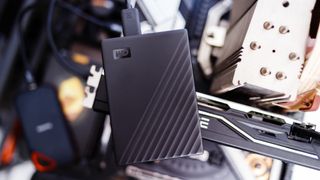
2. WD My Passport
Our expert review:
Specifications
Reasons to buy
Reasons to avoid
If you’re on the hunt for a new external hard drive, WD’s My Passport is an excellent choice. With a solid track record, password protection, and capacities of up to 5TB, it’s prepared to store a lot -- if not all -- of your data and keep it safe.
As street prices have started to fall, it's become a better value than ever. It looks good and comes backed by a plentiful 3-year warranty. To top things off, it boasts top-notch AES 256-bit hardware encryption password protection to keep your content secure from prying eyes.
Read: WD My Passport 5TB Review
Those looking to spend a little less, who also don't need 5TB of storage, should consider Seagate's Backup Plus Ultra, which features a good software suite, AES 256-bit encryption, and USB-A and USB-C support via an adapter.
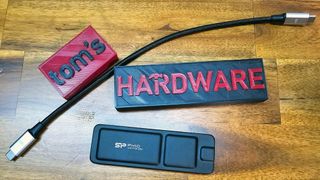
Specifications
Reasons to buy
Reasons to avoid
Silicon Power might not have the same name recognition as Samsung or WD, but the Taiwanese company churns out products that are often impressive, particularly in terms of value. And the PX10 portable SSD is another of those products, offering some of the best peak speed we've seen from a 10 Gbps drive, as well as sustained performance that, while not quite as good as competing drives from Crucial and Samsung, still hovers above 800 MB/s.
So pro users who often dump terabytes of files into and off of their drives should probably spend $15-30 extra for Crucial's X9 Pro or Samsung's T7 Shield (depending on capacity and whatever sale prices you might find on any given day). These drives delivered roughly 150 MB/s faster write speeds in our 15-minute sustained test, which you'd definitely notice when moving massive files like raw video. But for those who aren't doing that kind of thing on a regular basis, Silicon Power's X10 Pro is a great performer at a very good price. Just be sure to check current prices before buying, because drives often go on sale, and SSD prices are expected to increase dramatically this year.
Read: Silicon Power PX10 review
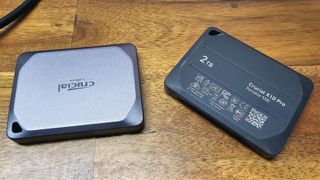
Specifications
Reasons to buy
Reasons to avoid
If you work with large files or libraries and can take full advantage the USB 3.2 Gen 2 2x2 interface, Crucial's X10 Pro is very fast and reasonably priced. It's also quite reasonably priced, at $170 for the 2TB model we tested, and $289 for the larger 4TB model. This, along with solid software and a compact, metal-clad shell makes it easy to recommend.
Just make sure, that you have the ports to take full advantage of its speed. If you have a system with Thunderbolt or 10Gb/s USB, like most of us, you can get a drive drives that will perform similarly on those ports for less money. Crucial's 10Gbps X9 Pro, for example, sells for under $130 for 2TB, or about $40 less than the speedier X10 Pro.
Read: Crucial X10 Pro (2TB) Review
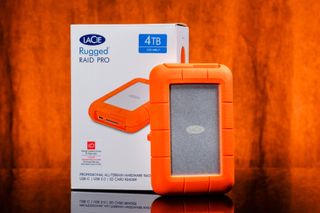
5. LaCie Rugged RAID Pro
Our expert review:
Specifications
Reasons to buy
Reasons to avoid
While it is on the pricey side, LaCie’s Rugged RAID Pro isn’t too overpriced considering its market placement and the peace of mind of data redundancy. LaCie includes one month of all Adobe apps for free, a $79.49 (£61) value. More importantly, the drive comes with three years of free data recovery protection. That service can (at times) cost thousands of dollars.
If you are a creative professional in the market for an external HDD, be sure to check this drive out. There aren't many competitors: Most other HDD solutions are much larger, and flash-based SSDs don’t yet offer similarly-priced capacity, nor the same value-adds. The LaCie Rugged RAID Pro 4TB has a unique blend of features and accessories that make it easy to use and quite the versatile travel companion.
Read: Lacie Rugged RAID Pro Review
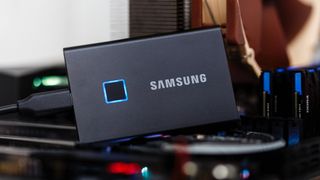
6. Samsung T7 Touch
Our expert review:
Specifications
Reasons to buy
Reasons to avoid
Samsung’s T7 Touch is an innovative portable SSD that blends USB 3.2 Gen 2 performance with convenient AES 256-bit hardware security that’s unlocked by the touch of your fingertip. The built-in fingerprint scanner is the most convenient way to unlock your data that we’ve seen yet. The design is elegant and to a higher standard than your ordinary run-of-the-mill portable drive. The aluminum construction is solid, and various color options are available to suit your unique taste.
That said, G-Technology's recent ArmorLock drive gives Samsung a run for its secure storage money, by using an app and key that's stored on your Android or iOS phone to unlock your drive. It may not be as convenient as swiping your finger across a sensor on your external SSD, but it might just be more secure.
Read: Samsung T7 Touch Portable SSD Review

7. Samsung X5
Our expert review:
Specifications
Reasons to buy
Reasons to avoid
Driven by an OEM variant of a Samsung 970 EVO and an Alpine Ridge Thunderbolt 3-to-PCIe bridge, Samsung’s X5 is the fastest Thunderbolt 3 portable SSD we’ve tested. Not only will it help speed up your workflow, but it also comes with an additional layer of AES 256-bit hardware-based encryption and password protection for those who need to meet compliance requirements. The three-year warranty is lacking for the professional crowd, and we wish the company offered more color options like those found with the company’s T5 and T7 portable SSDs.
Read: Samsung X5 Portable SSD Review
How We Test External SSDs
Our current testbed consists of an ASRock Z790 Taichi Lite motherboard and a Core i5-12600K CPU. This system gives us native Thunderbolt 4 ports and a USB 3.2 Gen 2 2x2 port via the front header (connected through Corsair's 5000D Airflow case).
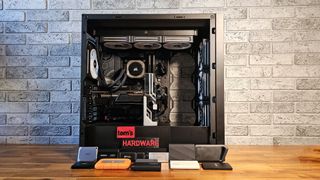
We run several tests on the external drives we test, with a mixture of real-world and synthetic benchmarks, and both sequential and small file (4K) reads and writes.
Trace Testing: PCMark 10 Storage Benchmark
PCMark 10 is a trace-based benchmark that uses a wide-ranging set of real-world traces from popular applications and everyday tasks to measure the performance of storage devices. We report both the proprietary overall score, as well as the bandwidth measured during the test.
Transfer Rates: DiskBench
We use the DiskBench storage benchmarking tool to test real-world file transfer performance with a custom 50GB dataset. We copy 4,617 files (images, videos, and software ISO files) to a folder on the test drive (write). Then, after leaving the system idle for five minutes, we run the same test in reverse, moving the test folder to a different location on our PCIe 4.0 testing drive. This is a separate drive from our boot drive, to avoid slowdowns due to the operating system background tasks that can be difficult to control for.
Synthetic Testing: CrystalDiskMark
CrystalDiskMark (CDM) is a free and easy-to-run storage benchmarking tool that SSD companies commonly use to assign product performance specifications. It gives us insight into how each device handles different file sizes. We run this test at its default settings.
The sequential read and write test effectively amounts to a best-case scenario, which often closely aligns with the read /write specs that drive makers put in their specs and on the product box.
The 4K read / write test, meanwhile, is more of a measure of how well the drive handles a plethora of small files, the kind of workload you might encounter when running a program, an OS, or a game directly from the drive.
Sustained Write Performance: Iometer
A drive's rated write specifications are only a piece of the performance picture. Most external SSDs (just like their internal counterparts) implement a write cache, or a fast area of flash, programmed to perform like faster SLC, that absorbs incoming data.
Sustained write speeds often suffer tremendously when the workload saturates the cache and slips into the "native" TLC or QLC flash. We use Iometer to hammer the SSD with sequential writes for 15 minutes to measure the size of the write cache and performance after the cache is saturated.
This test in particular tends to separate so-called "professional" drives from the rest. Those who often dump massive file libraries onto their external drives, often filling entire drives up in one go, need fast sustained write speeds. More casual storage users, on the other hand, are more likely to write smaller files or libraries of 100GB or less. These kinds of users can still benefit from fast sustained writes, but it may not be as necessary if you rarely or never write enough data to your drive at once from a fast enough source to burn through an SSD's fast SLC cache.
You can also make your own external SSD
Note that, if you have a spare drive, you can easily make your own portable drive. Dozens of 2.5-inch drive enclosures can be found online for between $10-$25 (£15-25) that will let you drop in an old drive easily, and turn it into an external hard drive or SSD.
And if you have an M.2 drive that you've swapped out of a gaming laptop, ultrabook or upgraded away from in your gaming PC, we've recently looked at NVMe enclosures from MyDigitalSSD and Pluggable. If you have a SATA-based M.2 drive that you'd like to turn into a portable drive, Silverstone's MS09 enclosure lets you do just that. And if you're keen on building your own speedy external SSD but don't have a drive handy to use, the recent WD Blue SN550 is a good candidate for that task. It's only available in capacities up to 1TB, but it's plenty speedy for external storage, and the more spacious model is already selling for as little as $115 at various online outlets.
Just make sure you get an enclosure that matches your drive, be that SATA or NVMe. And also keep in mind that DIY external drives usually aren't sealed, so they're not as likely to stand up to dust and dampness as well as external SSDs and portable hard drives that are designed to do so.
Finding Discounts on the Best External Storage Drives
When shopping for an external drive or SSD, consider the following:
- Portable Hard Drive or SSD? Drives that have spinning storage platters inside are very affordable, with 1TB models often selling for under $50 (£40). But they’re also much slower and more fragile than solid-state drives. If you don’t need terabytes of storage and you often travel with your drive, a portable SSD is worth paying extra for. A portable SSD will also be much faster at reading and writing lots of data. But if you need cavernous amounts of external storage, one of the best hard drives is a better option for most, as multi-terabyte external SSDs sell for several hundred dollars, but 4TB portable hard drives often sell for under $100 (£90).
- What USB connection? You can get a drive with a USB or Thunderbolt interface that operates at up to 5 Gbps (USB 3.x), 10 Gbps (USB 3.1 / 3.2 Gen 2), 20 Gbps (USB 3.2 Gen 2x2) or 40 Gbps (Thunderbolt or USB 4), but you'll pay more for the privilege. If you are getting an external SSD and your PC has at least one 10 Gbps port, we recommend spending a little extra to upgrade to 10 Gbps. The 20 and 40 Gbps speeds are nicer, but not worth it unless you are a creative professional.
- How much capacity? For full-system backups of a computer with a 1 to 2TB internal SSD, a 1TB external storage drive should be adequate because imaging software such as Acronis uses a lot of compression. For backing up personal collections of photos and family videos, look at the total GB of data you have and get a drive that's at least 50% higher capacity so for file stash has room to grow. If you're a creative professional that works with uncompressed media such as RAW files, a 4TB external storage drive is ideal, and usually far more affordable than these models were even a year ago.
- Don’t Use a Portable Hard Drive as Your Only Backup. Portable hard drives are made up of spinning glass or metal platters, making them a poor choice as a primary backup of your data--especially if you carry them around. Portable SSDs are better here, but you should still keep your irreplaceable data backed up on a desktop drive and / or on a cloud service. Because hardware failure is always possible, and portable drives are often small enough to lose or leave behind by accident.
Whether you're shopping for one of the best external storage drives or one that didn't quite make our list, you may find savings by checking out the latest Crucial promo codes, Newegg promo codes, Amazon promo codes, Corsair coupon codes, Samsung promo codes or Micro Center coupons.
MORE: Best SSDs
MORE: Best Hard Drive
MORE: How We Test HDDs And SSDs
MORE: All SSD Content
Stay on the Cutting Edge
Join the experts who read Tom's Hardware for the inside track on enthusiast PC tech news — and have for over 25 years. We'll send breaking news and in-depth reviews of CPUs, GPUs, AI, maker hardware and more straight to your inbox.
After a rough start with the Mattel Aquarius as a child, Matt built his first PC in the late 1990s and ventured into mild PC modding in the early 2000s. He’s spent the last 15 years covering emerging technology for Smithsonian, Popular Science, and Consumer Reports, while testing components and PCs for Computer Shopper, PCMag and Digital Trends.
-
Gingecat I thought the first item seemed too good to be true at £8.59 and I was right. I clicked on the Amazon link and turned out it wasReply
Khanka hard case carrying bag for SanDisk Extreme Portable SSD
Did the reviewer have too much to dream last night? -
Ksdomino 4TB hard drive is the best in 2020? Are you not aware that seagate released a portable (very good and equally reliable) 5TB drive in 2017?!?Reply
nearly 3 years later and we're still stuck with 5TB (apart from the reviewer that is stuck even lower at 4TB).. Am really hoping the 8TB portables don't take too long.
Edit: Also if you're going to recommend WD drives in Jan 2020 you might wanna look into the new WD Black drives. They also come in 5TB capacity but cost a bit more because performance. -
JSylvester ReplyKsdomino said:4TB hard drive is the best in 2020? Are you not aware that seagate released a portable (very good and equally reliable) 5TB drive in 2017?!?
nearly 3 years later and we're still stuck with 5TB (apart from the reviewer that is stuck even lower at 4TB).. Am really hoping the 8TB portables don't take too long.
Edit: Also if you're going to recommend WD drives in Jan 2020 you might wanna look into the new WD Black drives. They also come in 5TB capacity but cost a bit more because performance.
If you're looking for a portable 8TB, there aren't any single 2.5" HDD options. However, LaCie and Oyen Digital both offer a Rugged RAID that is 8TB in RAID0. Oyen Digital also offers a 10TB option.
For single drives, there are SSD options now that are at 8TB (7.68TB) Oyen Digital just released an 8TB SSD option in their MiniPro line. -
WarthogARJ ReplyAdmin said:Here are the best external hard drives and SSDs for the money. These drives offer the best balance of performance, features and price.
The Best External Hard Drives and Portable SSDs of 2019 : Read more
I think one metric for comparing storage is to look at Sustained Write Performance as well, because it affects anyone who needs to do a large write: whether it's just once a week, or else many times a day.
But I've looked at Tom's Hadware's Reviews, and it's hard to get enough details n the process used to perform the test, in order to relate it to other factors, and to other Revew sites. Or in fact to your existing SSD if you test it.
Specifically, when you do the Sustained Sequential 128kB Write test, what do you use for:
(1) Queue Depth?
(2) Conditioning the SSD before?
(3) Data recording frequency? (your charts are smooth lines, without any points to indicate the datum points). Do you do it 1 or two datum points per second, or is it by data volume, as in 1 datum per GB or so?
(4) Overprovisioning: do you control this, or do you use the "stock" settings?
The other review sites that do this type of test (Anandtech, TechPowerUp, Guru3D, TweakTown) supply sufficient detail to be able to use their test results.
Once you know the above, you can calculate other metrics such as IOPS and Latency. And with so many SSD variants made, it's not possible to find any single Review site that does them all, or even reviews the size you might want to buy.
Therefore you need to be able to compare benchmark results as best you can, but that means you need sufficent details on the critical parameters used.
i'm sure it's just an oversight on your part, you give details on other aspects.
Thank you for your feedback on this.
Regards,
Alan, Sheffield -
Snefferdy It would be nice if the people writing an article highlighting data transfer speeds knew the difference between a gigabyte (GB) and a gigabit (Gb). 1 GB = 8Gb!Reply
For example, the first drive (SanDisk) has an advertised top speed of 7.8 Gbps, not 80 Gbps as the authors state. -
MrMyke_S Just checking to see when folks started confusing hard and solidstate drives.Reply
I guess it was before this column started, even. -
Latte5570 this article doesn't discuss having a portal OS on any of these.Reply
are any of these practical to have a portable os installed on them and have it at usable speed? -
USAFRet Reply
The differing SSDs would make no difference.Latte5570 said:this article doesn't discuss having a portal OS on any of these.
are any of these practical to have a portable os installed on them and have it at usable speed?
A good drive is a good drive, a bad drive is a bad drive.
And for something like a bootable OS, you're still pumping all that through a USB/thunderbolt connection. Slow, as compared to an internal SATA or NVMe connection. -
Skramblr ReplyAdmin said:Here are the best external hard drives and SSDs for the money. These drives offer the best balance of performance, features and price.
The Best External Hard Drives and Portable SSDs of 2019 : Read more
I thought this article missed the backup aspect of having an External Drive. SSDs for a backup drive you plug in once a month is a huge waste of money.
Then I notice - This atricle has been recycled by TomsHardware for 3 years! They retitled it to best of 2022. WTH?

